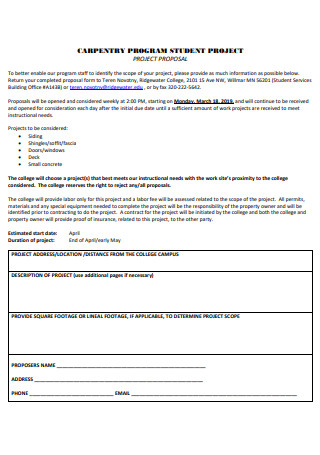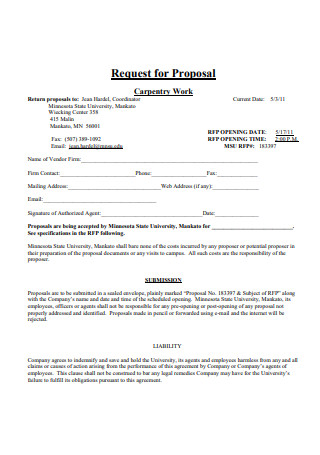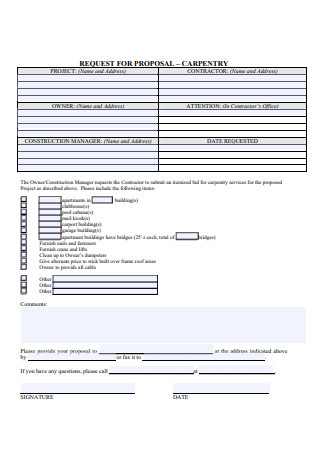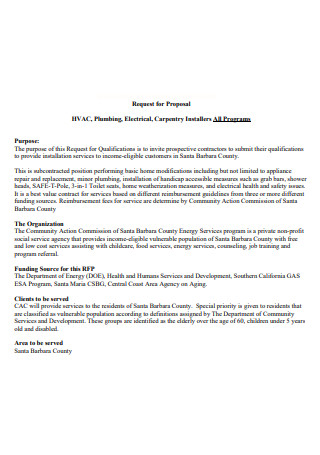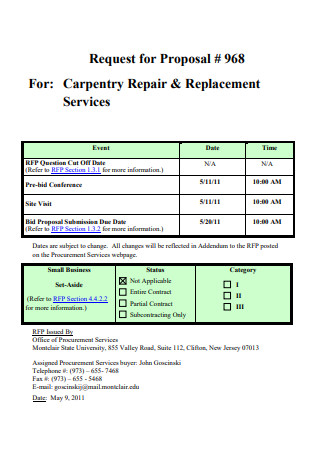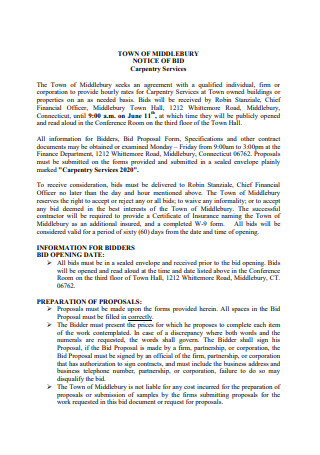5+ Sample Carpentry Proposal
FREE Carpentry Proposal s to Download
5+ Sample Carpentry Proposal
What Is a Carpentry Proposal?
What Are General Things that a Carpenter Does?
What Does a Carpenter Do in Construction Firms?
What Is the Work Environment of Carpenters?
What Is the Importance of Having a Carpentry Proposal?
Elements of a Carpentry Proposal
Steps in Writing Carpentry Proposal
FAQs
Is carpentry a good career?
What is a master carpentry?
What does a rough carpenter do?
What Is a Carpentry Proposal?
Carpentry proposals are written to introduce you as a carpenter and to solicit business from possible clients. It will include information about your experience and qualifications as a carpenter, case studies of your prior work, and your vision for the work of your potential client, as well as an estimate of the project’s time frame and expected budget, among other things.
Other templates are available on our website, and you can use them whenever you need them. They are as follows: internet proposal, buyout agreement, work contract, manufacturing proposal, position agreement, data report, business lease proposal, work agreement,carpentry trade service proposal, tenancy contract, franchise proposal, and other similar templates are available.
What Are General Things that a Carpenter Does?
Carpenters build, install, repair, and repair wooden structures and fixtures. Carpenters work on a variety of various types of construction, from highway and bridge construction to kitchen cabinet installation. Each carpentry task is unique, although the majority follow the same basic processes. Carpenters begin by laying out the structure—measuring, labeling, and arranging materials—in line with local construction rules. They use hand and power tools such as chisels, planes, saws, drills, and sanders to make custom wood, plastic, fiberglass, or drywall. They next use nails, screws, staples, or adhesives to secure the materials together. Finally, carpenters use levels, rules, plumb bobs, framing squares, and surveying equipment to verify the accuracy of their work and make any necessary corrections. Certain materials are prefabricated, making installation easier and faster.
Carpenters might perform a variety of various carpentry tasks or specialize in one or two. For example, carpenters who repair homes and other structures require a diverse set of carpentry skills. They may frame walls and partitions, install doors and windows, construct stairs, install cabinets and molding, and do a variety of other jobs as part of a single job. Carpenters with sufficient training can transition from home construction to commercial construction or renovation work, depending on which sector offers the best job possibilities.
What Does a Carpenter Do in Construction Firms?
Carpenters who work for large construction companies or specialty contractors may execute only a few routine tasks, such as erecting scaffolding or constructing wooden forms for concrete pouring. Certain carpenters construct tunnel bracing, or brattices, in subterranean passageways and mines to regulate airflow through the passageways and to workplace areas. Others construct concrete forms for projects such as tunnel, bridge, or sewer construction.
Outside the construction business, carpenters do a number of installation and maintenance tasks. They may replace glass panes, ceiling tiles, and doors, in addition to repairing desks, cabinets, and other pieces of furniture. Carpenters install partitions, doors, and windows; change locks; and repair broken furniture, depending on their job. Carpenters may assist in the relocation or installation of machinery in manufacturing enterprises.
What Is the Work Environment of Carpenters?
Carpentry labor can be physically demanding, just as it is in other construction industries. Standing, climbing, bending, and kneeling for extended periods of time are frequently required. Carpenters are at danger of injury when they work with sharp or rough materials, when they use sharp tools and power equipment, and when they work in environments where they can slip and fall. A high frequency of nonfatal injuries and illnesses is experienced by workers in this occupation as a result of this situation. Carpenters who work outside are also subjected to a variety of weather conditions, which can be dangerous. A conventional 40-hour week is worked by many carpenters; however, others work longer hours. Part-time employment accounted for approximately 7% of the workforce.
What Is the Importance of Having a Carpentry Proposal?
It’s unfortunate that many people regard the carpentry proposal template as an obnoxious document that they should never have been required to produce in the first place. This is why some contractors delegate it to interns or junior employees. This is because they assume they already know what has to be done, as a result of their industry experience. This is the furthest thing from the truth. You may even need to employ specialized software that handles multiple jobs concurrently to assist you in keeping track of and managing everything appropriately. The following are some of the reasons why you should guarantee that you devote sufficient attention to this proposal timeline.
1. Duration of the Project that Is Reasonable
This paper will assist you in determining whether or not the project length specified by your client is realistic and doable. There is not a single contractor alive who fantasizes about taking on a job that will take an eternity to complete. This is because failing to meet a deadline typically leads in late completion fees.
2. Calculate Your Estimates
More often than not, most contractors enjoy a resourced schedule, and for good reason. It provides you with an excellent opportunity to calculate, verify, or estimate your tender requirements. Generally, it is prudent to file a tender for a project, along with the bid price. This benefits the client since it demonstrates that you have thoroughly reviewed the project and are aware of the steps necessary to execute it.
3. Client Responsibilities
A solid proposal should also inform the client of some of their responsibilities related to the project’s completion. A excellent example is when the client is required to supply the contractor with unique access to specific resources or information, without which the contractor may be unable to perform their work properly.
4. Forecasting Cash Flow
When developing your proposal, you should be able to anticipate the project’s cash flow requirements based on this. Numerous contractors have genuinely failed to complete their projects, not due to their inability to do the task correctly, but due to a lack of finances. This occurs when you do large-scale tasks. Typically, this occurs because the contractor has embarked on a project that is either too large for their financial resources or has unfavorable financial terms of payment. This ultimately depletes their cash reserves.
5. Changing Essential Routes
With an expert-written proposal, you’ll learn how to finish a project more quickly and efficiently. With all of the resources available to you, you may find a more efficient way to accomplish a 36-week project in 32 weeks and use the remaining time for something else, which may result in your project finishing ahead of schedule.
6. Sequencing of Activities
You will be able to reorganize the method activities are gonna be carried out in this proposal. Some can be expanded, while others can be cut to improve resource efficiency. This allows you to lower resource needs during peak periods while maintaining a constant supply of resources to assist you in successfully completing the project. This will safeguard your project against forced resource demobilization or remobilization, which is frequently associated with additional and higher expenses.
7. Keep an Eye Out for Milestones
When the construction bid proposal template is properly prepared, you may set the team’s goals and milestones, as well as the deadlines for meeting them. With this information, you can determine the most effective strategy for attaining the given objectives.
8. Keep an Eye on Supply and Vendors
A schedule should be established for tracking the dates and times when specific items will be required on the construction site, as well as when they will be delivered. This will also assist you in monitoring the suppliers’ and subcontractors’ delivery processes.
9. Subcontractors Who Serve as Guides
Additionally, the right schedule should be provided to the subcontractors. When included in their contract document, this aids them during the tendering process, ensuring that they have a firm grasp on the duration of the construction project and the resources required of them. This will effectively lower the likelihood of conflicts or claims in the long run.
10. Mobilization of Resources
Proper resource mobilization can be planned in advance, allowing you to determine the type of resources you require and when they are required. When a project is not adequately planned, the result is typically a project with either too many or too few resources available at any given time, simply because the management did not comprehend the nature of effective project resourcing while developing their project proposal.
11. Observance of Obligations
Unfortunately, there are some contractors that view the free construction proposal form as a way for their customer to penalize them for work completed or to castigate their efforts in some way. This, however, is far from the truth. A well-written project proposal serves as a means of ensuring that both you and the client are on the same page, and more significantly, that the client will adhere to their duties appropriately and on schedule. If you need to make a valid claim for a time extension, you will need a construction proposal that has been duly signed and accepted by all parties concerned.
12. Feedback
Additionally, it is through this proposal that you will receive feedback on your progress. By periodically returning to the schedule, you can determine whether the project is on track to be completed on time or if additional financing will be required. If you discover a lapse in progress in good time, steps can be done to avoid it from spiraling out of control, resulting in increased resource commitments or extended work shifts.
13. Management of Projects
Many businesses disregard this critical document out of concern of having to meet their pledges, particularly regarding the completion date, or of having to invest more time and resources to make things right if something goes wrong. However, many are unaware that this is a document that may facilitate effective project management and, more crucially, ensure that the client meets their expectations and obligations.
Elements of a Carpentry Proposal
A strong carpentry proposal should also protect you, your business, and your best interests. There are five critical factors that must be included in any construction contract, and omitting them might result in major vulnerabilities:
The Parties’ Identities: This is one of the needs that may seem self-evident but is sometimes missed by many inexperienced contractors. However, the building proposal must include the identities of the persons involved, as this is how it becomes a legally binding document. It must include the parties’ names, signatures, and addresses. If this is not delivered in a timely way, it will be impossible for the contract to be enforced or to be regarded legally enforceable in a court of law.
The Project’s Scope: This is a requirement of any construction contract, particularly given the importance of the details involved. This section of your construction proposal is designed to outline the services that each of the companies involved will provide. A transcription of the grade of work, schedule, quality, materials, and any other features or descriptions necessary to see the construction project through should be included.
Cost and Payment Terms: This is a critical section of the construction proposal since it details the cost of the services being given and any additional charges that may occur beyond the scope of the construction project. Additionally, payment schedules, or milestones, the sums to be cleared upon attainment of specified milestones, and any terms and circumstances governing the release of these payments should all be clearly stated.
Routine of Work: The work schedule is intended to serve as a reminder of when the project will begin and end. Additionally, it must include the date on which the contractors were notified to proceed with the job. Simultaneously, it is mandatory to specify the amount of the contractor’s liabilities in the construction bid proposal form, including delays caused by the property or project owner’s failure to get appropriate approvals, easements, or licenses, or even delays caused by inclement weather. You should be aware of the distinction between working and calendar days. There should also be a provision for supplier lead times, and if the planned orders change, you should indicate how this will effect the project’s delivery timetable and how much more time you will need to build in.
Authorities Who Are Pertinent: Such projects are enormous, and as a result, numerous smaller projects are being performed within the larger project, the completion of which will result in the completion of the overall project. It is critical to identify the various parties who will be in charge at various phases of the project(s) and who will have the legal ability to enter into legally binding commitments at each level. This should be determined prior to the start of the project.
Steps in Writing Carpentry Proposal
Regardless of the cost of your project, the proposal is often written to safeguard everyone involved. It paints a clear image of what the carpenter intends to undertake in order to accomplish the client’s objectives. This proposal will also demonstrate to the client that you are not only a competent carpenter who approaches their job professionally, but also a good way to resolve disagreement during and after the project’s completion.
-
1. Indicate the Particularity
When drafting the free carpentry proposal template for your construction project, it is critical to be as specific as possible with the facts you give. Everything must be precise and exact to the smallest detail, particularly the scope of work. This is intended to protect your business from being forced to perform duties that were not part of your mandate or from being penalized for failing to accomplish something you were not supposed to do in the first place. There are numerous instances where clients and contractors come into dispute because the client anticipated the contractor to perform one or two tasks that the contractor did not, or worse, because the client assumes that a particular activity was included in the proposal when it was not.
-
2. Indicate Payment Difficulties
Frequently, when a dispute between the client and the contractor arises, the client withholds funds until the conflict is settled. In rare instances, a project that was proceeding successfully may encounter obstacles as a result of the client believing they have been shortchanged. Eventually, the carpenter may be forced to agree to undertake a task they were not contracted to perform in order to obtain the client’s money.
-
3. Include Limitation of Liability
As long as the client pays the full amount agreed upon in the contract and also pays for any changes or change orders made during the course of the project to the maximum extent permitted by law, the contractor’s guarantee is to complete the work to completion and to the desired and projected outcome agreed upon earlier.
-
4. Include the Resolution of Disagreements
When the unexpected occurs and a dispute is impending, it is critical to resolve the conflict as soon as feasible. Each carpenter and client hopes that this never happens, but in the event that it does, you must be prepared.
This is a straightforward feature, but without it, or if there are any flaws, you risk creating uncertainty throughout the project, as no one is certain who should take responsibility for a specific task.
FAQs
Is carpentry a good career?
Carpentry is a wonderful job for those looking to work from home. Having the ability to cut, shape, and finish wood opens up a world of other moneymaking alternatives. With little initial costs, you may be able to start doing interesting carpentry jobs from home.
What is a master carpentry?
The Master Carpenter constructs, mounts, and riggs the scenery under the technical director’s supervision. They normally work with a carpenter crew. They may also be in charge of maintaining scene-shop supplies and equipment.
What does a rough carpenter do?
Carpentry is a wonderful job for those looking to work from home. Having the ability to cut, shape, and finish wood opens up a world of other moneymaking alternatives. With little initial costs, you may be able to start doing interesting carpentry jobs from home.
Creating this proposal and arranging everything from the activities, to accomplishing the goal, and allocating the budget may be a difficult task to accomplish. There are a lot of resources out there that can help, including those on our site, so don’t hesitate to use them.

